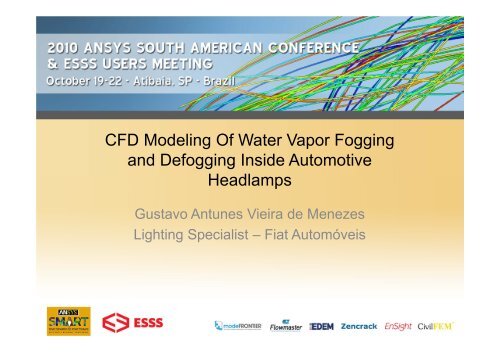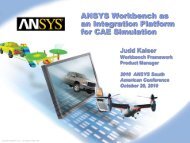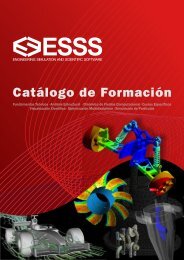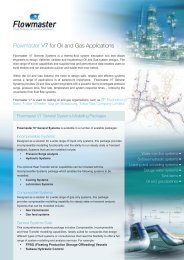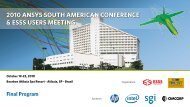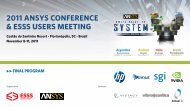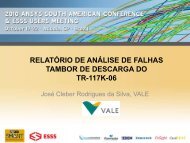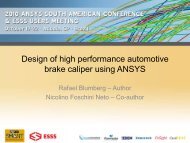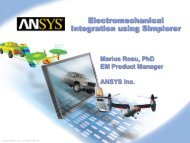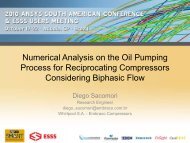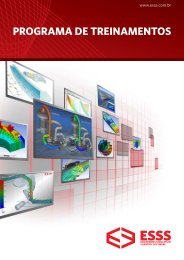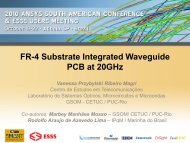CFD Modeling Of Water Vapor Fogging and Defogging ... - ESSS
CFD Modeling Of Water Vapor Fogging and Defogging ... - ESSS
CFD Modeling Of Water Vapor Fogging and Defogging ... - ESSS
Create successful ePaper yourself
Turn your PDF publications into a flip-book with our unique Google optimized e-Paper software.
<strong>CFD</strong> <strong>Modeling</strong> <strong>Of</strong> <strong>Water</strong> <strong>Vapor</strong> <strong>Fogging</strong><br />
<strong>and</strong> <strong>Defogging</strong> Inside Automotive<br />
Headlamps<br />
Gustavo Antunes Vieira de Menezes<br />
Lighting Specialist – Fiat Automóveis
PRESENTATION TOPICS<br />
• Company Overview;<br />
• Problem Description;<br />
• Methodology;<br />
• Results;<br />
• Conclusion <strong>and</strong> next steps.
Company Overview<br />
Foundation Date: 1976<br />
Number of employees: 22.377<br />
Annual capacity of production: 800.000<br />
vehicles<br />
Annual sales: R$ 20,6 billion<br />
Fiat Automobiles Brazil is the main<br />
market of the Fiat Group Automobiles<br />
out of Italy. The production of the<br />
Brazilian plant represents 30% of the<br />
total production of the FGA.
Problem Description<br />
• When the Headlamps lens started to be produced completely transparent, the<br />
condensation becomes more visible to the clients <strong>and</strong> beginning to be a quality<br />
problem.<br />
• Nowadays this problem can be detected only when the project is concluded<br />
<strong>and</strong> the manufacture tools are completely done. At this time is very difficult <strong>and</strong><br />
expensive doing any modification.<br />
•For this reasons is necessary develop a methodology to simulate water vapor<br />
fogging <strong>and</strong> defogging on the interior of automotive headlamps.
Methodology<br />
• Code: ANSYS FLUENT 12.1<br />
– Linked with fogging/defogging DFM modulus (Fluent Inc)<br />
• Laminar flow<br />
– The fluid is moved only by natural convection<br />
• Discrete ordinates radiation model (Fivel<strong>and</strong> & Jamaluddin, 1989)<br />
• Fluid: Humid air as ideal gas<br />
– Volumetric fraction according the relative humidity prescribed calculated by<br />
the balance equation.
Methodology<br />
Boundary Conditions to Simulate the <strong>Fogging</strong> <strong>and</strong> <strong>Defogging</strong><br />
O min Start condition • Temperature: 25 ºC<br />
• Relative Humidity: 95%<br />
• All the lamps off<br />
0 min → 30 min Heating • Temperature: 25 ºC<br />
• Relative Humidity: 95%<br />
• All the lights on with the direction indicator flashing at<br />
the frequency 1,5Hz.<br />
• Engine working temperature: 90ºC<br />
30 min → 35 min <strong>Fogging</strong> • <strong>Water</strong> temperature (focusing on external lens): 25 ºC<br />
• Temperature: 25 ºC<br />
• Relative Humidity: 100%<br />
• All the lamps off<br />
35 min → 60 min <strong>Defogging</strong> • Temperature: 25 ºC<br />
• Relative Humidity: 95%<br />
• All the lamps off
Results - Heating<br />
Temperature on the External Surface of the Lens
Results - Heating<br />
Temperature on the Internal Surface of the Lens
Results - Heating<br />
Relative Humidity on the Internal Surface of the Lens<br />
High relative humidity points
Results - Heating<br />
Air get into the<br />
Headlamp
Results - Heating<br />
Air get into the<br />
Headlamp<br />
Air get out the<br />
Headlamp
Results - Condensation
Results - Condensation<br />
Temperature on the Internal Surface of the Lens
Results - Condensation<br />
<strong>Fogging</strong> on the lens after a condensation test
Results - Evaporation<br />
The water film evaporate quickly at this step because of two reasons:<br />
• The temperature of the lens increase (internal heat exchange).<br />
•The relative humidity decrease to 95%.
Results - Evaporation<br />
Temperature at the Internal Surface of the Lens
Conclusion <strong>and</strong> next steps.<br />
• The <strong>CFD</strong> simulation were capable to represent the three steps of the<br />
automotive headlamps condensation test: heating, condensation <strong>and</strong><br />
evaporation.<br />
• Some boundary conditions: heating time <strong>and</strong> water temperature, must<br />
be adjusted to simulated better the most severe conditions that could<br />
be found during the vehicle life.<br />
• Will be necessary modify the actual condensation st<strong>and</strong>ard test to<br />
achieve a better correlation between physical test <strong>and</strong> <strong>CFD</strong> simulation.


